Before you leave...
Take 20% off your first order
20% off
Enter the code below at checkout to get 20% off your first order
Discover summer reading lists for all ages & interests!
Find Your Next Read

By relying on the educational models of Wilberforce University and Morehouse College, this study gathered historical artifacts that provide critical responses to the following research questions: What were the similarities and differences between the social, historical, political and cultural forces that led to the founding of the colleges? What were the similar and different motivations and interests of the founding leaders? What were the similar and different effects of these founding leaders on their institutions in their time period? What similar and different supports did these institutions receive from their religious organizations? What can we learn from the impact of these institutions on Black higher education over the last 150 years?
The project sets out to answers the aforementioned research questions through the following Chapters. Chapter 1, Purpose of the Study, provides an overview of the research topic and contextualizes the study by identifying the research questions. This Chapter provides a brief introduction to the history of Black higher education during Reconstruction in the US. It then describes the institutional context of the time period to show the need for research on this topic and to articulate the study's significance. The second chapter, Research Design and Methodology, outlines the historical method and approach to this study. This Chapter defines and explains the selection of scientific management as the educational theory underpinning this study. It also defines and explains the use of Dr. Jim Laub's renowned servant leadership Organizational Leadership Assessment (OLA) model. Chapter 3, Historical Background and Context, articulates the central problem, critical issues, and historical context that have inspired this research study. This Chapter assesses the social, historical, political and cultural forces that led to the founding of the colleges by providing a historiography of Black education during Reconstruction, while detailing its development and continued struggles. It also develops the thesis that Black education during Reconstruction was the natural by-product of the pre-existing struggle of African-American communities to achieve empowerment and self- improvement.
The fourth chapter, Founding Presidents and their Institutions, provides a biographical introduction to the personal and professional experiences of Bishop Daniel Alexander Payne during his tenure as President of Wilberforce University, 1865-1876 and Rev. Dr. Joseph Robert's tenure as President of Morehouse College, 1871-1884. Accordingly, the focus of this Chapter is fourfold. First, it elaborates the core aspects of Dr. Daniel Alexander Payne's tenure as President of Wilberforce University. It, then, shifts to draw out the phases of the historical development of Wilberforce University. Thirdly, it elaborates the key constituents of Dr. Joseph Robert's presidency of Morehouse College. And lastly, it maps out the historical development of Morehouse College. Chapter 5, Institutional Comparisons focuses on conducting institutional and leadership profile assessments. The institutional assessment includes a demographical and mission-based comparison of the colleges. In the concluding chapter, Chapter 6, the conclusion builds from the research questions to determine what can be learned from the impact of these institutions on Black higher education over the last 150 years. And how their accomplishments can be used as guidelines for contemporary institutional development, curricula development, Christian education, gender studies, the improvement of Black colleges, and lastly how to mold exemplary presidents to lead these unique institutions.
Thanks for subscribing!
This email has been registered!
Take 20% off your first order
Enter the code below at checkout to get 20% off your first order